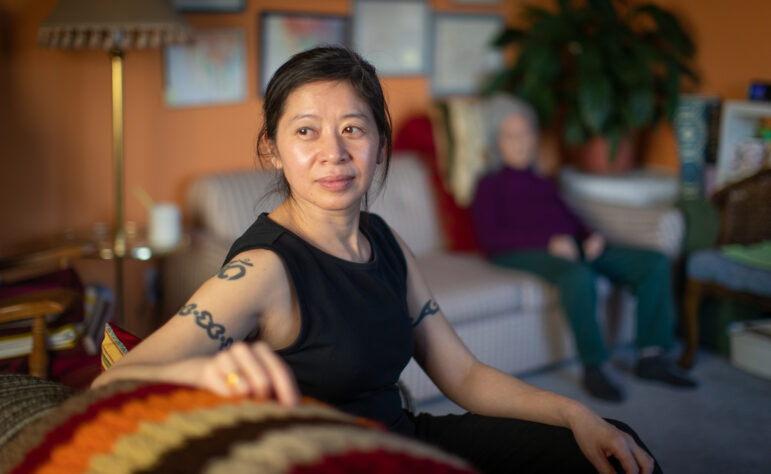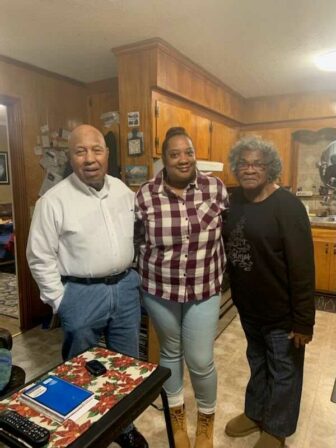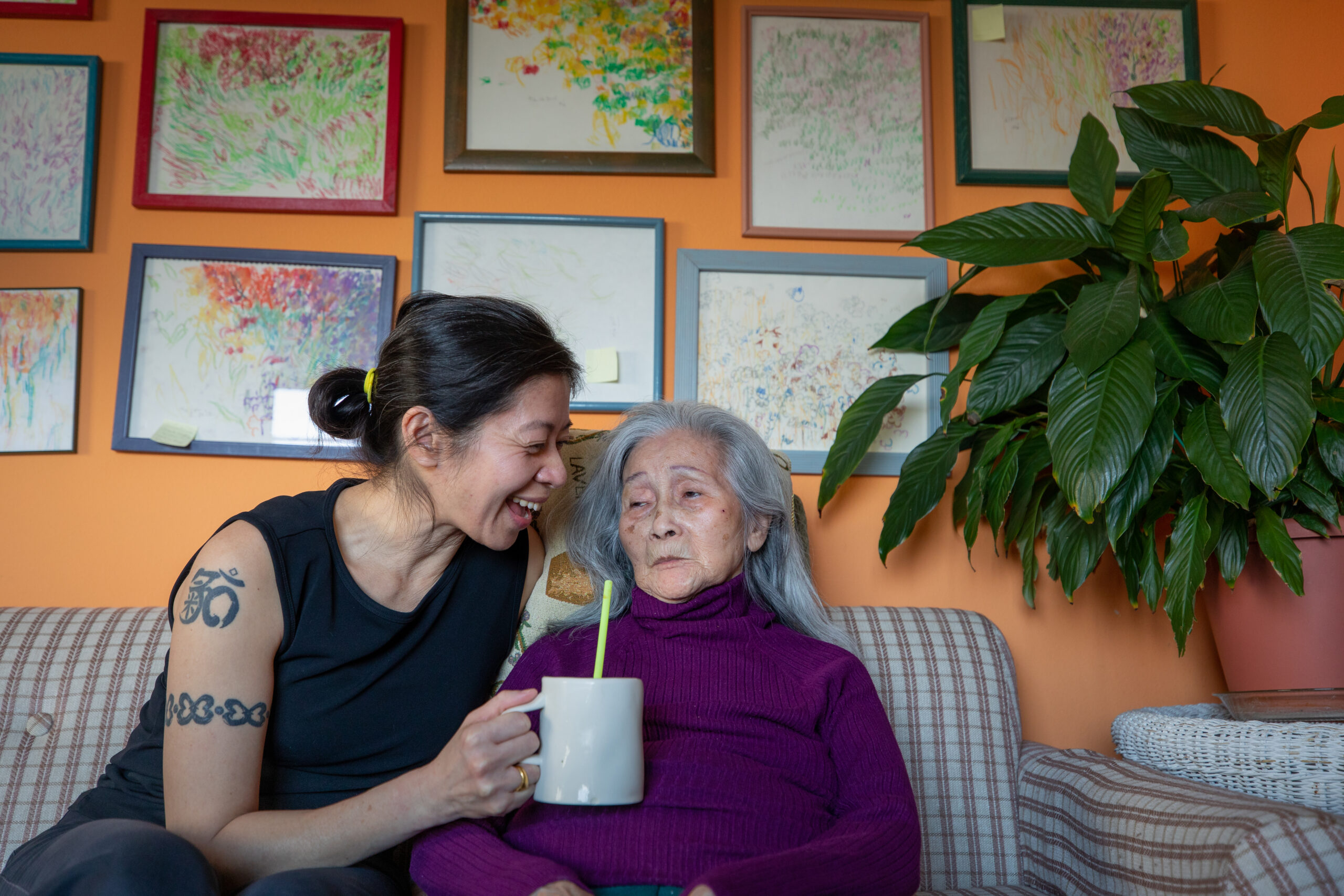‘Inside-the-home transmission is what has been killing so many older people of color’
Nursing home social worker Sang Nguyen lived in constant fear that he’d bring COVID-19 home to his parents and his 78-year-old grandmother. He knew from his job how deadly the coronavirus could be for older people with pre-existing health conditions.
So the family began hunkering down last year at home in Puyallup.. Nguyen’s parents, 46 and 55, both have underlying health issues and suspended operations at their nail salon. Nguyen’s teenage siblings stayed inside to attend high school online. His grandmother continued to divide her time between the Nguyen home and another child’s house.
Nguyen, 25, had no choice but to report to work and try his best to avoid infecting his multigenerational family. He’d enter his house after work through the garage, take off his clothes to disinfect them and immediately shower.
“I felt like COVID was truly consuming me,” Nguyen said of the strain.

Sang Nguyen, 25, lives in a multigenerational household with his siblings, parents and grandmother in Puyallup, Washington. According to the National Asian Pacific Center on Aging, 42% of Asian American and Pacific Islanders are family caregivers, compared to 22% of the general population.
Washington is among only a handful of states that have both recognized COVID-19’s threat to multigenerational households and have prioritized the distribution of vaccines accordingly. A Center for Public Integrity analysis of every county in the U.S. shows that people of color, at greater risk from the virus for a variety of factors, are far more likely to be living in the same home as older relatives.
Washington became the first state to put multigenerational households near the top of its COVID-19 vaccine priority list on Jan. 6[S1] .
Like other states, Washington followed federal guidance and first prioritized “high risk” health care workers, first responders and nursing home residents — the latter of whom account for about a third of COVID-19 deaths nationwide. But Washington broke new ground when it next prioritized people 65 or older and people 50 and older in multigenerational homes in which they care for grandchildren, parents or receive care at home.
The rollout hasn’t always been smooth, according to some activists representing communities of color who pushed for it. But prominent virus experts are urging other jurisdictions, as vaccine supplies grow, to also target multigenerational homes as an effective way to reach communities of color.
The Center for Public Integrity’s analysis found that 18% of U.S. households are multigenerational. We define these households as consisting of at least two generations. That includes parents and adult children as well as families that extend from grandparents to grandchildren. The percentage among people of color is much higher: 30% among Latinos, 25% among Asians and 24% among Black families, compared to 15% for non-Latino white households.
Multigenerational households include millions of Americans and immigrants who live with extended family to suit elders’ needs, for cultural reasons or because it’s more affordable. Not coincidentally, health experts say, ethnicities with elevated rates of multigenerational homes are suffering infections and death rates greater than their white counterparts of all ages.
“Inside-the-home transmission is what has been killing so many older people of color,” said Dr. Ashish Jha, a leading global public health expert and dean of the Brown University School of Public Health.
Jha agrees with other specialists that vaccinating essential workers, from teachers to farmworkers, is crucial to stop the spread of the virus.
But early vaccination of essential workers alone “probably is not enough,” Jha said. “We really do need to find ways to prevent the intergenerational spread of the infection in these households.”
These households often consist of people of color, who have less access to health insurance and higher rates of health problems that make COVID-19 more deadly.
Focusing vaccine access on the most vulnerable populations, regardless of age, would require prioritizing people of color because they have more underlying health conditions, said Dr. James Hildreth, president of Meharry Medical College, a historically Black medical school in Nashville, Tennessee.
“What’s keeping that from happening is that it appears to be prioritizing based on race, and in today’s United States,” Hildreth said, “that’s just not gonna fly.”
President Joe Biden wants all adults to be eligible for vaccines no later than May 1, but it’s been left to individual states to determine who should be prioritized in the meantime.
‘It felt like we were invisible’
As anticipation of a vaccine release grew last year, leaders in Washington’s immigrant communities and communities of color asked the state to designate multigenerational families as an early high priority.
About 22% of Asian households in the state are multigenerational. But “it felt like we were invisible,” said Seattle resident Trang Tu, who lives with and cares for her 90-year-old mother, Nguyet Dang.
Last summer, a federal advisory group tasked with developing plans for fairly distributing the vaccine began wrestling with the concerns of multigenerational families. The advisers suggested that local officials have latitude to vaccinate entire households regardless of age if experts thought it would be more efficient and equitable at protecting vulnerable communities.
Tu, 48, joined a Dec. 20 Zoom meeting for the public with representatives of the Centers for Disease Control and Prevention. Knowing that vaccine would be in short supply initially, CDC advisers had already recommended Dec. 1 that vaccines first go to health care workers and residents of long-term care facilities where outbreaks had been so deadly.
The CDC also issued a statement at the time suggesting that as vaccine supply increased, it was open to future recommendations prioritizing multigenerational households.
In late December, updated guidance from CDC advisers recommended that individuals ages 75 and up and “frontline essential workers” next receive vaccines, followed by those 65 and older, other essential workers, and people 16 to 64 with high-risk medical conditions. The CDC didn’t explicitly prioritize multigenerational households for vaccines, as Washington state had, but did recognize that a greater percentage of elders of color live in them.
States largely adopted CDC vaccine priority guidelines. But since states were allowed flexibility to design their own plans, Tu focused on influencing her home state of Washington.
COVID-19 fatality rates in Washington have been disproportionately higher among households of color. Since the pandemic began, the death rate among Native Hawaiians and Pacific Islanders has been six times higher than for white residents. Latino, Native American and Alaskan death rates have been three times higher. And it’s been nearly twice as high for Black residents.
Multigenerational households often include essential workers, such as Sang Nguyen, who are at greater risk of bringing the virus home. Then there are those caring for frail elders, such as Trang Tu, who don’t have priority eligibility for vaccines because they aren’t employed at a health care facility.

Trang Tu of South Seattle lives with and cares for her 90-year-old mother, Nguyet Dang. Tu joined a call with Washington state health officials deciding about the priority for the vaccine rollouts. She and others from communities of color asked the state to designate multigenerational families as an early high priority. (Photo by Scott Eklund/Red Box Pictures for InvestigateWest)
Katie Meehan, the Washington Department of Health’s equity and social justice manager, said prioritizing multigenerational families was “one of the strongest themes” that emerged in talks with community representatives last fall.
At least three other states have adopted versions of Washington’s policy.
Alaska began vaccinating people 45 and older in multigenerational households in February. The Alaska Tribal Health System was already doing this. Crucially, older adults may be more inclined to get vaccinated when they can do so with a family member, said Clinton Bennett, a spokesman for the Alaska Department of Health and Social Services.
In early March, Minnesota began expanding eligibility to people 50 and up in homes with at least three generations, such as a grandparent, parent and grandchild.
Oregon plans on also targeting multigenerational households for vaccines. Officials in Multnomah County, home to Portland, plan to consult with community organizations on which types of households should qualify. “You can see how many people might define that differently,” said Jessica Guernsey, the county’s public health director.
Most states are now vaccinating those 65 and older. That group accounts for eight out of 10 COVID-19 deaths. But the age limit cuts out younger people of color, many likely to live in multigenerational households, who face disproportionate risks compared with white peers.
That’s why Jha, the Brown University expert, recommended in February that states lower the limit to 55 to reach vulnerable communities.
Data supports his point.
Among people ages 55 to 64, Black and Latino death rates are at least five times higher than for white people, according to the Brookings Institution, which analyzed CDC data.
COVID-19 hits multigenerational counties
Some of the counties Public Integrity found to have exceptionally large concentrations of multigenerational households have also been ravaged by COVID-19.
In the Latino-majority border community of Webb County, Texas, 36% of households are multigenerational, one of the highest concentrations in the country. At least 1 in 6 residents has been infected, and close to 30% of residents lack health insurance. In two California counties, San Bernardino and Imperial, two majority Latino counties, 30% of households are multigenerational. Elsewhere in the country, these households are common among white families in West Virginia, Kentucky and other parts of Appalachia.
The South is home to large proportions of Black multigenerational households, especially in the Mississippi Delta.
Mississippi announced March 15 that it will allow anyone 16 and older to try to book an appointment. That allows Paege Fuller, 35, to start trying. Fuller and her son, 11, moved back to Jackson from Houston, Texas, after she lost her job due to the pandemic. Fuller is Black, as is 38% of Mississippi’s population. Although Black residents account for roughly 39% of COVID-19 deaths, the state estimates they were only 28% of those vaccinated through March 22.
Fuller lives with her mother, who works outside the home. She helps her grandparents, 86 and 87, who live nearby, shop and attend church virtually on an iPad. Fuller struggled for days to make a vaccine appointment for them, too. Her grandparents finally got shots in February. But the whole family is still fearful, especially as variants of the virus circulate that may be partially resistant to the vaccine.
“Those are my grandparents,” Fuller said. “They took care of me, so it’s my time to take care of them, and I want them around as long as possible.”

The Fuller family, from left to right: Willie Belt, Paege and Mildred Belt. (Courtesy of the Fuller family)
The Muriels, a Latino family in Florida’s Hernando County, know how easily the virus can spread inside a larger household.
In their Gulf Coast community north of Tampa, about 19% of households are multigenerational, one of the biggest concentrations in Florida. The Muriel household includes Kathy, 59, her husband, 58, and four sons, ages 24 to 32. They all tested positive for COVID-19 last year.
The family tried to fend off the virus with handwashing, masks and distancing in public. But it was unnatural to be so careful at home. “By the time we figured out, ‘I think you may have COVID,’ we all went down within a week’s time,” Kathy said.
For months last summer, the family fought the virus’ stew of symptoms: sore throat, body ache, fever chills, fatigue and eyeball pain. They’ve all recovered but worry that a variant could return like an unwanted and potentially deadly guest.
Florida is prioritizing seniors 65 and older but recently opened eligibility to those older than 50. Kathy and her husband can try to make an appointment now. One of her sons, a nursing home worker, was vaccinated in February.
But Kathy’s other adult sons must continue to wait.
California: ZIP codes to get to families
In California, Imperial County public health workers fan out before dawn to find farmworkers to vaccinate. They hope their focus helps protect members of multigenerational families, close to one in three of all households here. In Los Angeles County — 27% multigenerational — labor activists also pushed for vaccinating people at work to try to protect hard-hit blue-collar households.
Imperial is one of America’s primary vegetable-growing regions, with workers toiling through the pandemic. Last June, the county had the highest COVID-19 death rate in California. It’s still a high-risk community, with at least one in seven people estimated to have been infected.
California health officials have a different approach to reach multigenerational families in Imperial and similar counties. The state is sending 40% of its vaccine supply to ZIP codes in the lowest quartile of an index it calls Healthy Places.
One factor in that score: how crowded the housing is.
“It is the most equitable way to distribute our still-limited vaccine supply,” the state said in a factsheet about its plan. The state also reserves appointments in a registration system for residents in “disproportionately affected communities.”
Imperial County Health Officer Dr. Stephen Munday said that targeting multigenerational households “certainly makes a lot of sense,” but the county is following the state’s plan. Munday also pointed out that early studies didn’t determine how effective vaccines were at preventing people from spreading the virus because they still could carry it and appear asymptomatic.
Though inconclusive, new data shows signs that some vaccines could reduce transmission. If confirmed, Munday said, it’s possible health officials could develop strategies that include building “mini herd immunity” within multigenerational homes.
Rocky rollout in Washington
Washington state health officials have translated COVID-19 vaccine web pages into multiple languages. Community groups are helping schedule appointments for eligible multigenerational households with members 50 and older. And nobody’s asking for proof of eligibility at sites, officials say, because they want people to feel comfortable coming forward.
Yet the campaign has still left some people out, according to Joseph Seia, executive director of the Pacific Islander Community Association of Washington.
Forcing people to go online to book a time at mass vaccine sites, he said, has been a “Hunger Games”-like competition excluding elders and essential workers who don’t sit at desks with computers. He’s booking appointments at pop-up clinics targeting neighborhoods where residents face disproportionate risk of infection and death.
Sang Nguyen was vaccinated before he resigned from his nursing home job in February. His grandparents and parents were eligible weeks later as members of a multigenerational household, but several appointments they made were cancelled. Not enough vaccines, they were told.
They were finally vaccinated in mid-March — a relief for the whole family.
To identify the location and number of multigenerational families in the United States, the Center for Public Integrity analyzed 2019 Census Bureau microdata collected by IPUMS USA at the University of Minnesota.
Microdata collected for five years by the bureau’s American Community Survey includes respondents’ answers to questions about each member in a household and their relationships to one another. We identified households consisting of two generations or more. Such households could include a parent or a grandparent who lived with an adult child or a grandchild.
The survey includes information about each member of the household. To identify the ethnicity or race of the household, we used the characteristics of whomever the family designated as the head of the household.
Our estimates are based on Public Use Microdata areas (PUMA), the smallest geography available for the American Community Survey. We converted those PUMA estimates to the county level using a block-level crosswalk table from the Missouri Census Data Center.
The data for this analysis and the code to reproduce is available on GitHub.
Featured image: Trang Tu of South Seattle lives with and cares for her 90-year-old mother, Nguyet Dang. (Photo by Scott Eklund/Red Box Pictures for InvestigateWest)



